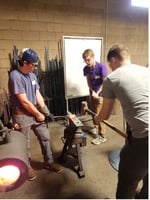At Chiz Bros., we believe that educating the next generation of industry professionals is critical...
Quick Guide to Ceramic Fiber Module Electric Element Systems
In industrial furnace applications, ceramic fiber insulation proves effective in thermal management. Besides its well-known advantages, ceramic fiber also provides unique benefits that enhance durability, efficiency, and ease of maintenance. This post highlights where ceramic fiber products and systems adds value with the versatility of Anchor-Loc® electric element systems.
Anchor-Loc Electric Systems
 Anchor-Loc Electric® ceramic fiber modules combine the proven quality and dependability of Anchor-Loc® modules with the mechanical support features required in furnace designs utilizing electric heating elements. The Fibermass® manufacturing technique used to fabricate Anchor-Loc Electric ceramic fiber modules utilizes a spun ceramic fiber blanket featuring high tensile strength for superior resistance to mechanical abuse and vibration. A proprietary fiber treatment decreases fiber dusting and irritation while increasing block flexibility, making the module easy to compress into place. Modules are available in two temperature grades based on construction from Durablanket® HP-S or Durablanket® 2600. The Anchor-Loc Electric module is manufactured with ceramic support tubes embedded within the module. Ceramic or alloy “S” hooks are attached to the ceramic tubes during block installation and serve to support and isolate the element.
Anchor-Loc Electric® ceramic fiber modules combine the proven quality and dependability of Anchor-Loc® modules with the mechanical support features required in furnace designs utilizing electric heating elements. The Fibermass® manufacturing technique used to fabricate Anchor-Loc Electric ceramic fiber modules utilizes a spun ceramic fiber blanket featuring high tensile strength for superior resistance to mechanical abuse and vibration. A proprietary fiber treatment decreases fiber dusting and irritation while increasing block flexibility, making the module easy to compress into place. Modules are available in two temperature grades based on construction from Durablanket® HP-S or Durablanket® 2600. The Anchor-Loc Electric module is manufactured with ceramic support tubes embedded within the module. Ceramic or alloy “S” hooks are attached to the ceramic tubes during block installation and serve to support and isolate the element.
The Weld-Loc® attachment system, offered as the standard fastener for Anchor-Loc Electric modules, eliminates casing penetrations, making the system compatible with a variety of furnace atmospheres. During installation, the Weld-Loc stud assembly is fused to the furnace casing and a hex nut is torqued on the threaded stud, drawing the module to the casing plate. This system’s design permits ease and speed of module installation.
For high-performance furnace operations, Anchor-Loc ceramic fiber modules can be integrated with electric heating systems to create customized insulation and element solutions. Chiz Bros partners with element suppliers to deliver complete system designs tailored to specific customer requirements. Applications include:
- Annealing Furnaces
- Normalizing Furnaces
- Tempering Furnaces
- Draw & Hardening Furnaces
- Brazing Furnaces
- Kilns & Laboratory Furnaces


Design Considerations
- Element Materials – Alloys such as nickel-chromium, iron chrome-aluminum, or refractory materials.
- Mounting Options – Sidewall, roof suspension, refractory piers, or direct floor placement.
- Tips for Extended Service Life:
- Design for accurate voltage supply (+/-10% variations affect power).
- Account for watt density and resistance rise at operating temperatures.
- Ensure correct voltage compatibility.
- Allow for expansion/contraction of elements to prevent hot spots.
- Install carefully, ensuring joints, terminals, and insulation penetrations are properly secured.
- Protect elements from contaminants such as oil, sulfur, or cleaning compound residue.
By integrating Anchor-Loc modules with electric element systems, furnace operators benefit from both proven thermal performance and reliable mechanical support, which helps to maximize operating life while maintaining efficiency.
Product Features/Benefits
The Anchor-Loc Electric ceramic fiber module provides many of the features and benefits found in the Anchor-Loc2 module
product line:
- Resistance to thermal shock permits rapid furnace heat-up and cooling cycles.
- Low heat loss and reduced heat storage increases furnace efficiency for lower operating costs.
- Ease and speed of installation provide a fast furnace turnaround, reducing downtime and increasing productivity.
Additional advantages which are provided by the Anchor-Loc Electric system include:
- Flexible placement of element support hardware on the module lining.
- Complete electrical and thermal insulation of the furnace casing from the heating elements.
- Reduced maintenance due to enhanced block tensile strength.
- Enhanced thermal stability of the lining, reducing shrinkage gaps and openings between modules.
Conclusion
With the current push to have more electrically heated furnace systems that can reduce a company's carbon footprint, it always important to consider the benefits of ceramic fiber.



